Previous issues
- Page Path
- HOME > Articles and issues > Previous issues
Editorial
- Neglected issues related to the COVID-19 pandemic
- Jong-Koo Lee
- Osong Public Health Res Perspect. 2023;14(3):149-150. Published online June 30, 2023
- DOI: https://doi.org/10.24171/j.phrp.2023.14.3.01
- 997 View
- 60 Download
Original Articles
- Risk factors associated with death due to severe fever with thrombocytopenia syndrome in hospitalized Korean patients (2018–2022)
- Jia Kim, Hyo-jeong Hong, Ji-hye Hwang, Na-Ri Shin, Kyungwon Hwang
- Osong Public Health Res Perspect. 2023;14(3):151-163. Published online June 8, 2023
- DOI: https://doi.org/10.24171/j.phrp.2023.0048
- 1,668 View
- 175 Download
-
 Graphical Abstract
Graphical Abstract
 Abstract
Abstract
 PDF
PDF 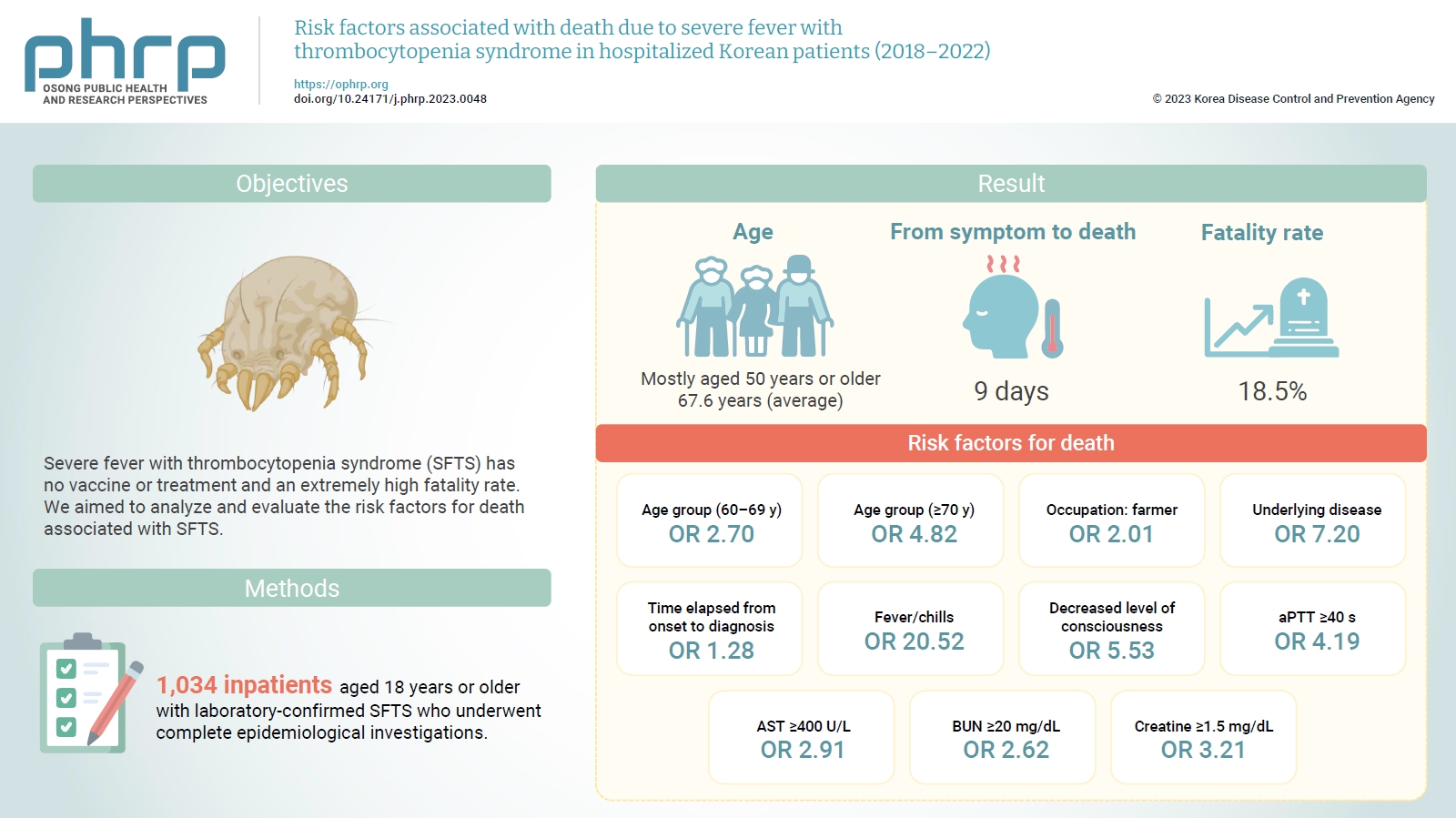
- Objectives
Severe fever with thrombocytopenia syndrome (SFTS) has no vaccine or treatment and an extremely high fatality rate. We aimed to analyze and evaluate the risk factors for death associated with SFTS.
Methods
Among reports from 2018 to 2022, we compared and analyzed 1,034 inpatients aged 18 years or older with laboratory-confirmed SFTS who underwent complete epidemiological investigations.
Results
Most of the inpatients with SFTS were aged 50 years or older (average age, 67.6 years). The median time from symptom onset to death was 9 days, and the average case fatality rate was 18.5%. Risk factors for death included age of 70 years or older (odds ratio [OR], 4.82); agriculture-related occupation (OR, 2.01); underlying disease (OR, 7.20); delayed diagnosis (OR, 1.28 per day); decreased level of consciousness (OR, 5.53); fever/chills (OR, 20.52); prolonged activated partial thromboplastin time (OR, 4.19); and elevated levels of aspartate aminotransferase (OR, 2.91), blood urea nitrogen (OR, 2.62), and creatine (OR, 3.21).
Conclusion
The risk factors for death in patients with SFTS were old age; agriculture-related occupation; underlying disease; delayed clinical suspicion; fever/chills; decreased level of consciousness; and elevated activated partial thromboplastin time, aspartate aminotransferase, blood urea nitrogen, and creatine levels.
- Estimating the number of severe COVID-19 cases and COVID-19-related deaths averted by a nationwide vaccination campaign in Republic of Korea
- Ji Hae Hwang, Ju Hee Lee, Eun Jung Jang, Ryu Kyung Kim, Kil Hun Lee, Seon Kyeong Park, Sang Eun Lee, Chungman Chae, Sangwon Lee, Young Joon Park
- Osong Public Health Res Perspect. 2023;14(3):164-172. Published online June 22, 2023
- DOI: https://doi.org/10.24171/j.phrp.2023.0096
- 1,729 View
- 116 Download
- 1 Web of Science
- 1 Crossref
-
 Graphical Abstract
Graphical Abstract
 Abstract
Abstract
 PDF
PDF 
- Objectives
The Korea Disease Control and Prevention Agency promotes vaccination by regularly providing information on its benefits for reducing the severity of coronavirus disease 2019 (COVID-19). This study aimed to analyze the number of averted severe COVID-19 cases and COVID-19-related deaths by age group and quantify the impact of Republic of Korea’s nationwide vaccination campaign.
Methods
We analyzed an integrated database from the beginning of the vaccination campaign on February 26, 2021 to October 15, 2022. We estimated the cumulative number of severe cases and COVID-19-related deaths over time by comparing observed and estimated cases among unvaccinated and vaccinated groups using statistical modeling. We compared daily age-adjusted rates of severe cases and deaths in the unvaccinated group to those in the vaccinated group and calculated the susceptible population and proportion of vaccinated people by age.
Results
There were 23,793 severe cases and 25,441 deaths related to COVID-19. We estimated that 119,579 (95% confidence interval [CI], 118,901–120,257) severe COVID-19 cases and 137,636 (95% CI, 136,909–138,363) COVID-19-related deaths would have occurred if vaccination had not been performed. Therefore, 95,786 (95% CI, 94,659–96,913) severe cases and 112,195 (95% CI, 110,870–113,520) deaths were prevented as a result of the vaccination campaign.
Conclusion
We found that, if the nationwide COVID-19 vaccination campaign had not been implemented, the number of severe cases and deaths would have been at least 4 times higher. These findings suggest that Republic of Korea’s nationwide vaccination campaign reduced the number of severe cases and COVID-19 deaths. -
Citations
Citations to this article as recorded by- Comparative Effectiveness of COVID-19 Bivalent Versus Monovalent mRNA Vaccines in the Early Stage of Bivalent Vaccination in Korea: October 2022 to January 2023
Ryu Kyung Kim, Young June Choe, Eun Jung Jang, Chungman Chae, Ji Hae Hwang, Kil Hun Lee, Ji Ae Shim, Geun-Yong Kwon, Jae Young Lee, Young-Joon Park, Sang Won Lee, Donghyok Kwon
Journal of Korean Medical Science.2023;[Epub] CrossRef
- Comparative Effectiveness of COVID-19 Bivalent Versus Monovalent mRNA Vaccines in the Early Stage of Bivalent Vaccination in Korea: October 2022 to January 2023
- Results of contact tracing for SARS-CoV-2 Omicron sub-lineages (BA.4, BA.5, BA.2.75) and the household secondary attack risk
- Mi Yu, Sang-Eun Lee, Hye Young Lee, Hye-jin Kim, Yeong-Jun Song, Jian Jeong, Ae Kyung Park, Il-Hwan Kim, Eun-jin Kim, Young-Joon Park
- Osong Public Health Res Perspect. 2023;14(3):173-179. Published online June 22, 2023
- DOI: https://doi.org/10.24171/j.phrp.2022.0285
- 1,375 View
- 58 Download
-
 Graphical Abstract
Graphical Abstract
 Abstract
Abstract
 PDF
PDF 
- Objectives
This study aimed to assess the contact tracing outcomes of severe acute respiratory syndrome coronavirus 2 (SARS-CoV-2) Omicron sub-lineages BA.4, BA.5, and BA.2.75 within Republic of Korea, and to generate foundational data for responding to future novel variants.
Methods
We conducted investigations and contact tracing for 79 confirmed BA.4 cases, 396 confirmed BA.5 cases, and 152 confirmed BA.2.75 cases. These cases were identified through random sampling of both domestically confirmed and imported cases, with the goal of evaluating the pattern of occurrence and transmissibility.
Results
We detected 79 instances of Omicron sub-lineage BA.4 across a span of 46 days, 396 instances of Omicron sub-lineage BA.5 in 46 days, and 152 instances of Omicron sub-lineage BA.2.75 over 62 days. One patient with severe illness was confirmed among the BA.5 cases; however, there were no reports of severe illness in the confirmed BA.4 and BA.2.75 cases. The secondary attack risk among household contacts were 19.6% for BA.4, 27.8% for BA.5, and 24.3% for BA.2.75. No statistically significant difference was found between the Omicron sub-lineages.
Conclusion
BA.2.75 did not demonstrate a higher tendency for transmissibility, disease severity, or secondary attack risk within households when compared to BA.4 and BA.5. We will continue to monitor major SARS-CoV-2 variants, and we plan to enhance the disease control and response systems.
- The COVID-19 pandemic and healthcare utilization in Iran: evidence from an interrupted time series analysis
- Monireh Mahmoodpour-Azari, Satar Rezaei, Nasim Badiee, Mohammad Hajizadeh, Ali Mohammadi, Ali Kazemi-Karyani, Shahin Soltani, Mehdi Khezeli
- Osong Public Health Res Perspect. 2023;14(3):180-187. Published online June 22, 2023
- DOI: https://doi.org/10.24171/j.phrp.2023.0041
- 1,376 View
- 66 Download
-
 Graphical Abstract
Graphical Abstract
 Abstract
Abstract
 PDF
PDF 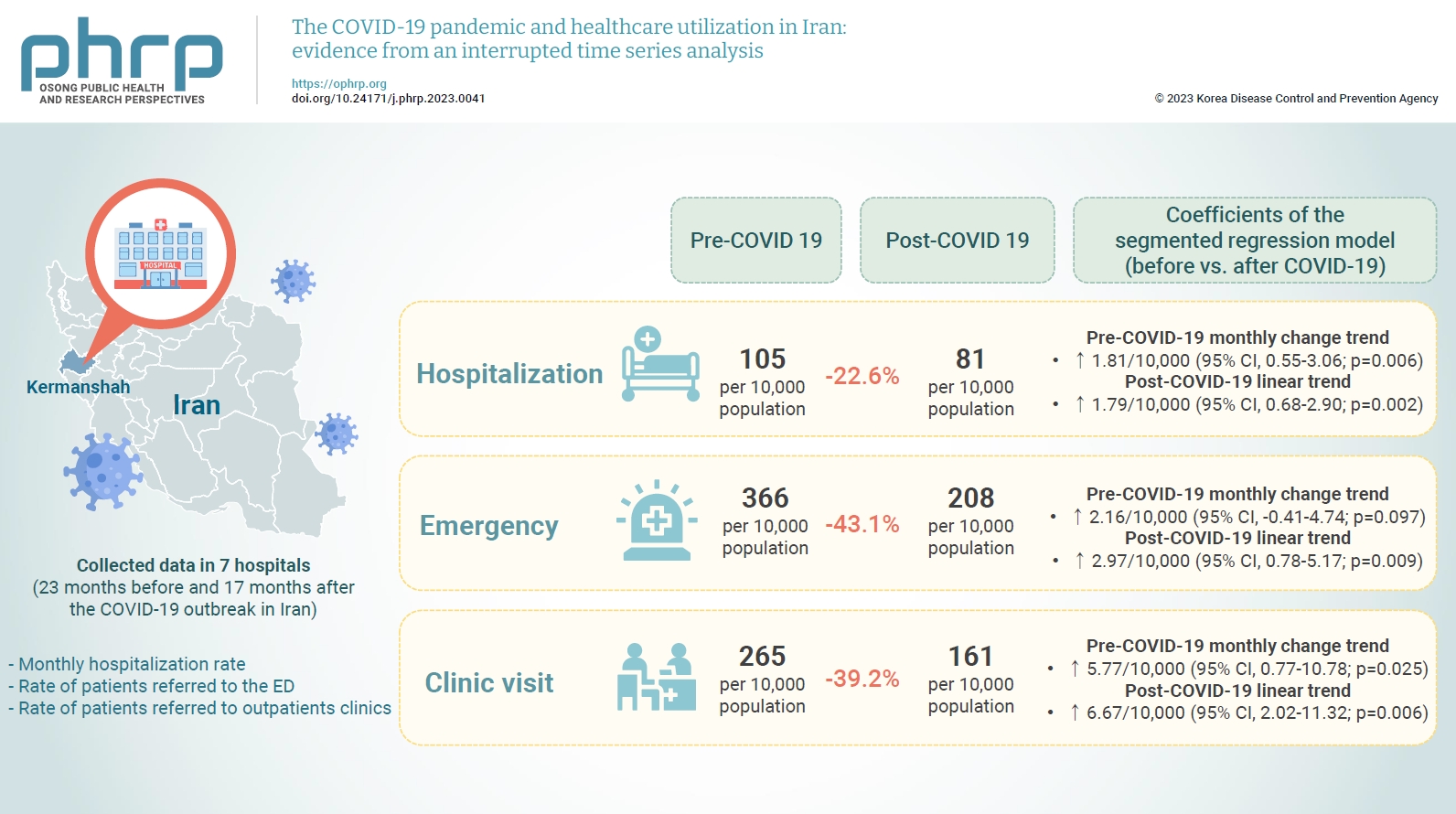
- Objectives
This study aimed to examine the effect of the coronavirus disease 2019 (COVID-19) outbreak on the hospitalization rate, emergency department (ED) visits, and outpatient clinic visits in western Iran.
Methods
We collected data on the monthly hospitalization rate, rate of patients referred to the ED, and rate of patients referred to outpatient clinics for a period of 40 months (23 months before and 17 months after the COVID-19 outbreak in Iran) from all 7 public hospitals in the city of Kermanshah. An interrupted time series analysis was conducted to examine the impact of COVID-19 on the outcome variables in this study.
Results
A statistically significant decrease of 38.11 hospitalizations per 10,000 population (95% confidence interval [CI], 24.93–51.29) was observed in the first month of the COVID-19 outbreak. The corresponding reductions in ED visits and outpatient visits per 10,000 population were 191.65 (95% CI, 166.63–216.66) and 168.57 (95% CI, 126.41–210.73), respectively. After the initial reduction, significant monthly increases in the hospitalization rate (an increase of 1.81 per 10,000 population), ED visits (an increase of 2.16 per 10,000 population), and outpatient clinic visits (an increase of 5.77 per 10,000 population) were observed during the COVID-19 pandemic.
Conclusion
Our study showed that the utilization of outpatient and inpatient services in hospitals and clinics significantly declined after the COVID-19 outbreak, and use of these services did not return to pre-outbreak levels as of June 2021.
- Vaccine effectiveness and the epidemiological characteristics of a COVID-19 outbreak in a tertiary hospital in Republic of Korea
- Seonhee Ahn, Tae Jong Son, Yoonsuk Jang, Jihyun Choi, Young Joon Park, Jiseon Seong, Hyun Hee Kwon, Muk Ju Kim, Donghyok Kwon
- Osong Public Health Res Perspect. 2023;14(3):188-196. Published online June 8, 2023
- DOI: https://doi.org/10.24171/j.phrp.2023.0066
- 1,462 View
- 72 Download
-
 Graphical Abstract
Graphical Abstract
 Abstract
Abstract
 PDF
PDF 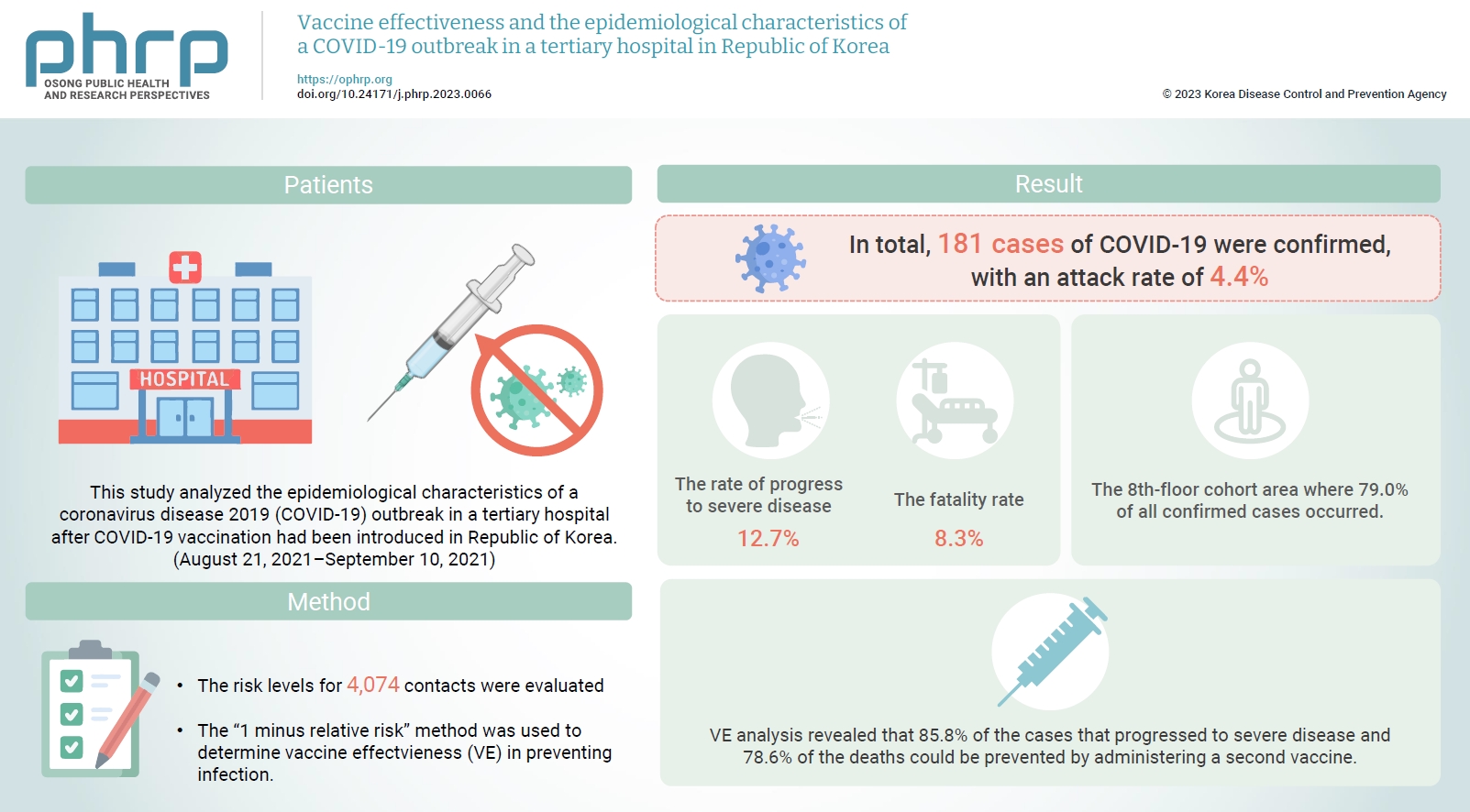
- Objectives
Healthcare facilities are high-risk sites for infection. This study analyzed the epidemiological characteristics of a coronavirus disease 2019 (COVID-19) outbreak in a tertiary hospital after COVID-19 vaccination had been introduced in Republic of Korea. Vaccine effectiveness (VE) and shared anti-infection strategies are also assessed.
Methods
The risk levels for 4,074 contacts were evaluated. The epidemiological characteristics of confirmed cases were evaluated using the chi-square test. The “1 minus relative risk” method was used to determine VE in preventing infection, progression to severe disease, and death. In the largest affected area (the 8th floor), a separate relative risk analysis was conducted. A multivariate logistic regression analysis (with 95% confidence interval [CIs]) was used to identify transmission risk factors with a significance level <10% via the backward elimination method.
Results
In total, 181 cases of COVID-19 were confirmed, with an attack rate of 4.4%. Of those cases, 12.7% progressed to severe disease, and 8.3% died. In the cohort isolation area on the 8th floor, where 79.0% of the confirmed cases occurred, the adjusted odds ratio was 6.55 (95% CI, 2.99–14.33) and 2.19 (95% CI, 1.24–3.88) for caregivers and the unvaccinated group, respectively. VE analysis revealed that 85.8% of the cases that progressed to severe disease and 78.6% of the deaths could be prevented by administering a second vaccine.
Conclusion
Caregiver training for infection prevention and control is necessary to reduce infection risk. Vaccination is an important intervention to reduce the risk of progression to severe disease and death.
- Effectiveness of the COVID-19 vaccine in the Honam region of the Republic of Korea
- In-Sook Shin, Yong-Pyo Lee, Seung-Hoon Lee, Jae-Young Lee, Jong-Ha Park, Yoon-Seok Chung
- Osong Public Health Res Perspect. 2023;14(3):197-206. Published online June 8, 2023
- DOI: https://doi.org/10.24171/j.phrp.2022.0308
- 1,881 View
- 63 Download
-
 Graphical Abstract
Graphical Abstract
 Abstract
Abstract
 PDF
PDF 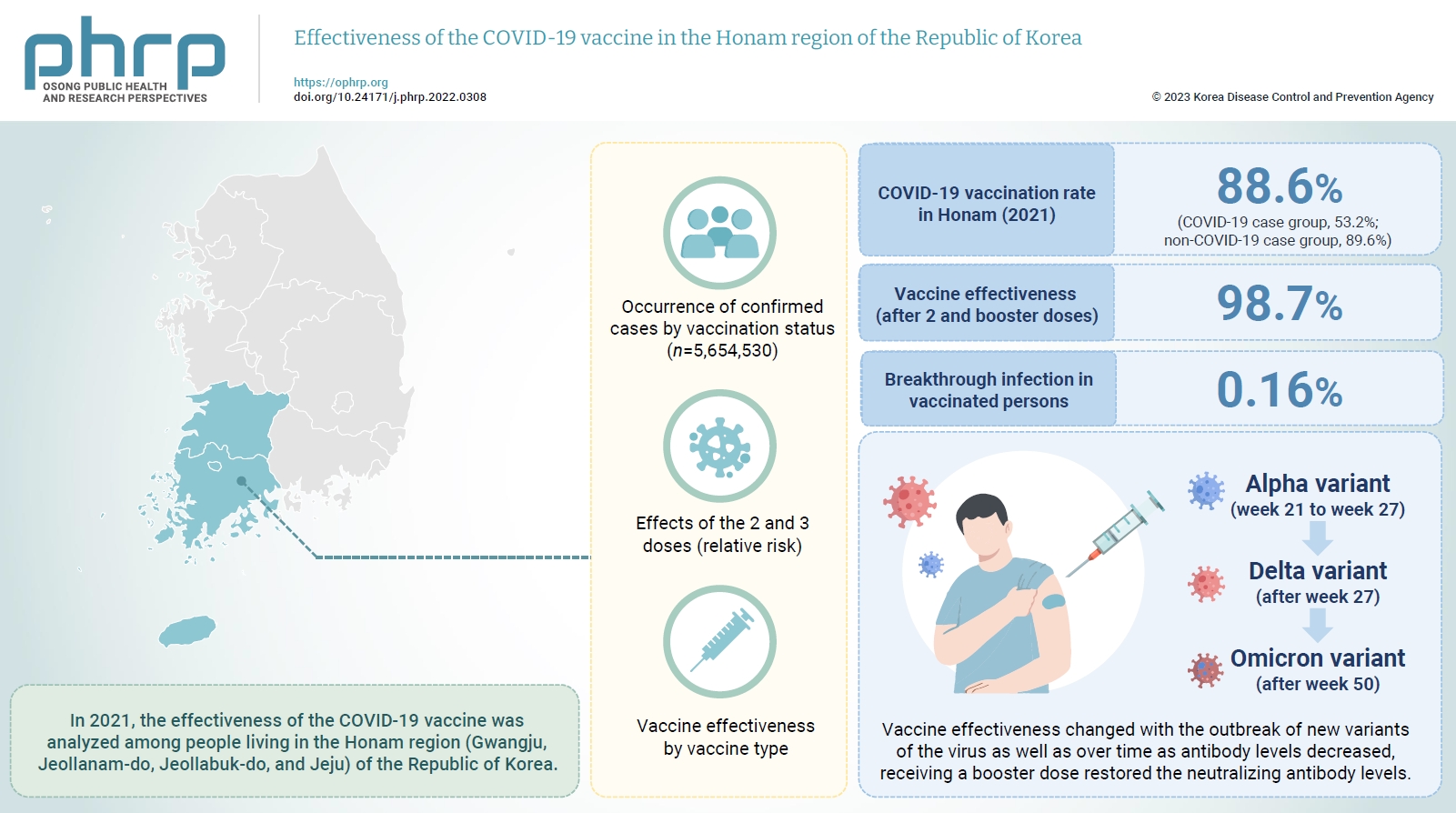
- Objectives
In 2021, the effectiveness of the COVID-19 vaccine was analyzed among people living in the Honam region (Gwangju, Jeollanam-do, Jeollabuk-do, and Jeju) of the Republic of Korea. And we investigated changes in the dominant virus strain.
Methods
This study used the data provided by the Korean Ministry of the Interior and Safety for individuals ≥12 years old in the Honam region, and the Integrated Disease and Health Management System of the Korea Centers for Disease Control and Prevention for COVID-19-vaccinated individuals as of December 31, 2021. Statistical analyzes were performed using IBM SPSS ver. 23.0. The occurrence of confirmed cases by vaccination status, the relative risk, and vaccine effectiveness by vaccine type were calculated.
Results
In 2021, the COVID-19 vaccination rate in Honam was 88.6%. The overall vaccine effectiveness (after 2 and 3 doses) was 98.7% (p<0.001). and the breakthrough infection rate was 0.16%. From week 21 to week 27 of 2021 (June 27 to July 3), the genome sequencing results were mostly alpha variants. The Delta variant emerged as the dominant variant after 27 weeks and the Omicron variant was found at 50 weeks (December 5–11).
Conclusion
Vaccine effectiveness changed with the outbreak of new variants of the virus as well as over time as antibody levels decreased. that the prevention effectiveness of vaccination in Honam was >98%, and the effect among persons who received 2 doses was >90% regardless of the vaccine type. Although vaccine effectiveness decreased because of reduced antibody levels over time (as observed in breakthrough infections), receiving a booster dose restored the neutralizing antibody levels.
- Risk factors for COVID-19 outbreaks in livestock slaughtering and processing facilities in Republic of Korea
- Seongju Choi, Tae Jong Son, Yeon-Kyung Lee
- Osong Public Health Res Perspect. 2023;14(3):207-218. Published online June 8, 2023
- DOI: https://doi.org/10.24171/j.phrp.2023.0035
- 1,220 View
- 48 Download
-
 Graphical Abstract
Graphical Abstract
 Abstract
Abstract
 PDF
PDF 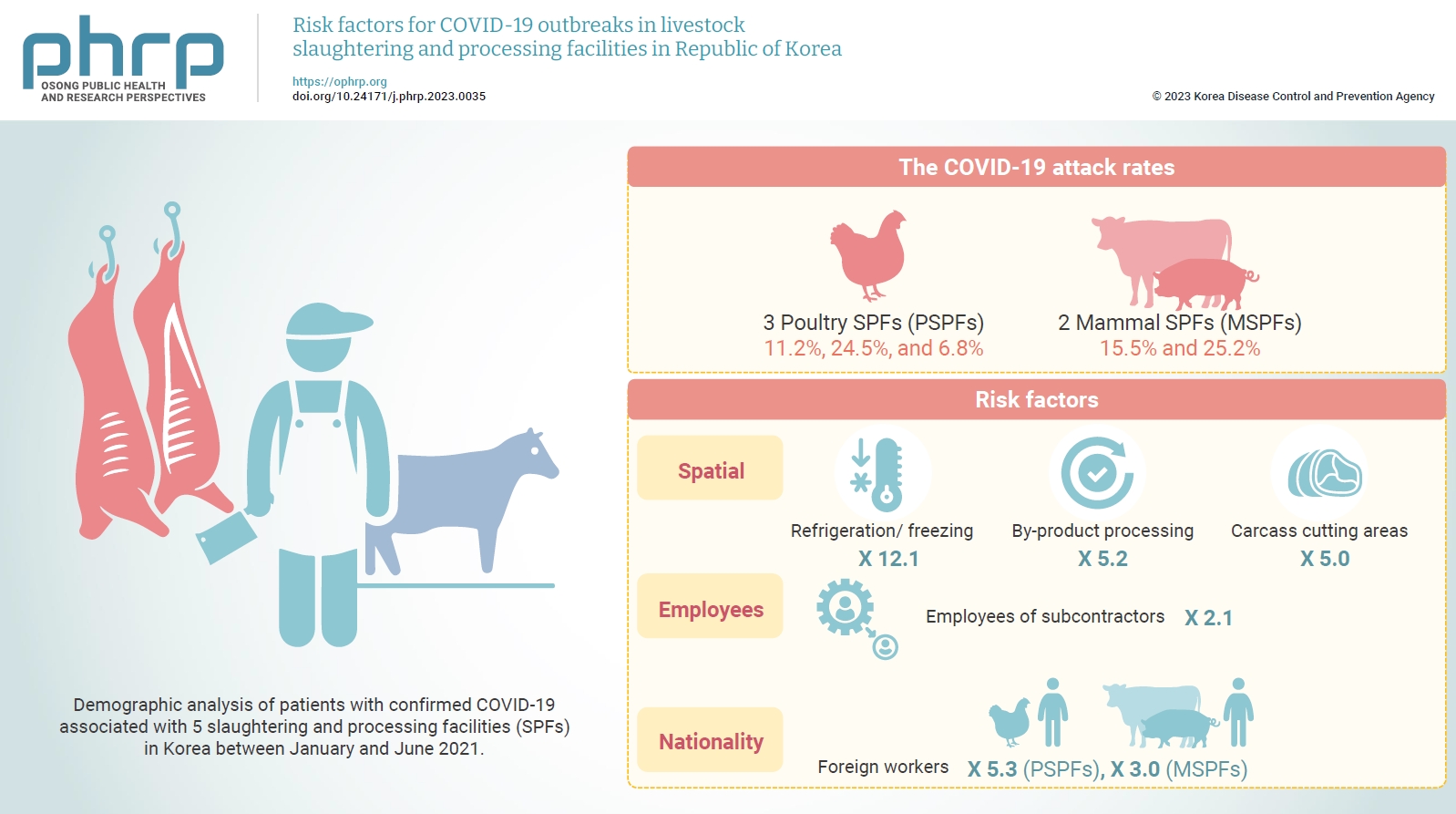
- Objectives
The goal of this study was to help prevent and control the spread of coronavirus disease 2019 (COVID-19) by identifying transmission routes and risk factors in livestock slaughtering and processing facilities (SPFs) and establishing an optimal intervention strategy for outbreaks.
Methods
This case series study was a demographic analysis of patients with confirmed COVID-19 associated with 5 SPFs in Korea between January and June 2021. Additionally, in a retrospective cohort study, the association between COVID-19 infection and risk factors was analyzed for SPFs at which outbreaks occurred.
Results
The COVID-19 attack rates were 11.2%, 24.5%, and 6.8% at 3 poultry SPFs (PSPFs) and 15.5% and 25.2% at 2 mammal SPFs (MSPFs). Regarding spatial risk factors, the COVID-19 risk levels were 12.1-, 5.2-, and 5.0-fold higher in the refrigeration/ freezing, by-product processing, and carcass cutting areas, respectively, than in the office area. The risk of COVID-19 infection was 2.1 times higher among employees of subcontractors than among employees of contractors. The COVID-19 risk levels were 5.3- and 3.0-fold higher in foreign workers than in native Korean workers in the PSPFs and MSPFs, respectively.
Conclusion
As the COVID-19 pandemic continues, a detailed policy for infectious disease prevention and control intervention is needed, without interrupting economic activities. Thus, we propose an ideal intervention plan to prevent COVID-19 through disinfection and preemptive testing and to block its transmission through effective contact management during outbreaks at SPFs.
Short Communication
- Correlations between regional characteristics of counties and the ratio of intracounty to extracounty sources of COVID-19 in Gangwon Province, Republic of Korea
- Seungmin Jeong, Chaeyun Lim, Sunhak Bae, Youngju Nam, Eunmi Kim, Myeonggi Kim, Saerom Kim, Yeojin Kim
- Osong Public Health Res Perspect. 2023;14(3):219-223. Published online June 8, 2023
- DOI: https://doi.org/10.24171/j.phrp.2023.0014
- 1,363 View
- 32 Download
-
 Graphical Abstract
Graphical Abstract
 Abstract
Abstract
 PDF
PDF 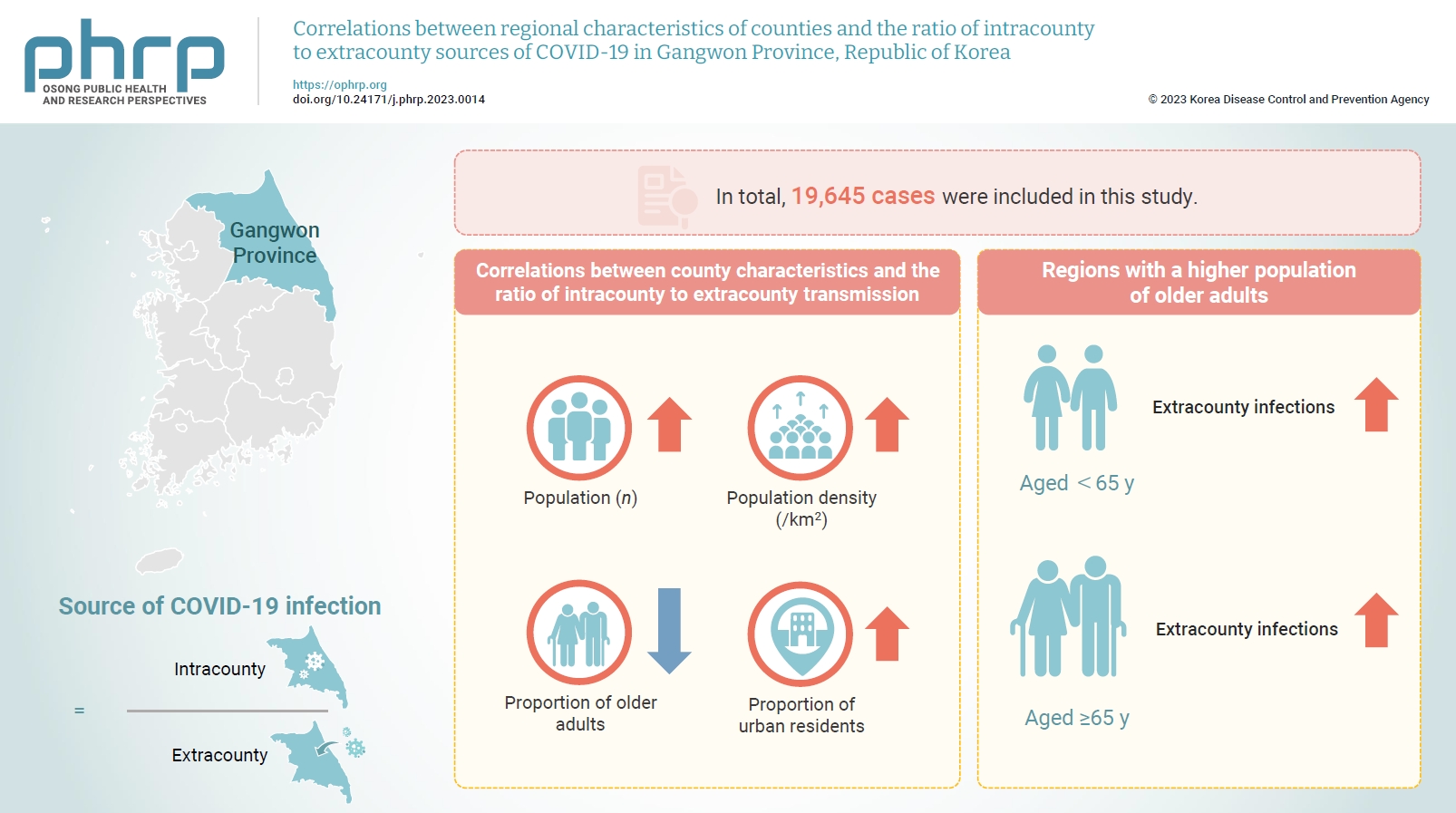
- Objectives
This study aimed to examine the correlations between the regional characteristics of counties in Gangwon Province, Republic of Korea and the ratio of intracounty to extracounty sources of coronavirus disease 2019 (COVID-19) infection.
Methods
The region of the infectious contact was analysed for each COVID-19 case reported in Gangwon Province between February 22, 2020 and February 7, 2022. The population, population density, area, the proportion of urban residents, the proportion of older adults (>65 years), financial independence, and the number of adjacent counties were assessed for each of the 18 counties in Gangwon Province. Correlation coefficients between regional characteristics and the ratio of intracounty to extracounty infections were calculated.
Results
In total, 19,645 cases were included in this study. The population, population density, proportion of older adults, and proportion of urban residents were significantly correlated with the ratio of intracounty to extracounty infections. A stratified analysis with an age cut-point of 65 years showed that the proportion of older adults had a significant negative correlation with the ratio of intracounty to extracounty infections. In other words, the proportions of extracounty infections were higher in countries with higher proportions of older adults.
Conclusion
Regions with ageing populations should carefully observe trends in infectious disease outbreaks in other regions to prevent possible transmission.
Brief Report
- Temporal association between the age-specific incidence of Guillain-Barré syndrome and SARS-CoV-2 vaccination in Republic of Korea: a nationwide time-series correlation study
- Hyunju Lee, Donghyok Kwon, Seoncheol Park, Seung Ri Park, Darda Chung, Jongmok Ha
- Osong Public Health Res Perspect. 2023;14(3):224-231. Published online June 22, 2023
- DOI: https://doi.org/10.24171/j.phrp.2023.0050
- 2,080 View
- 89 Download
- 1 Web of Science
- 2 Crossref
-
 Graphical Abstract
Graphical Abstract
 Abstract
Abstract
 PDF
PDF 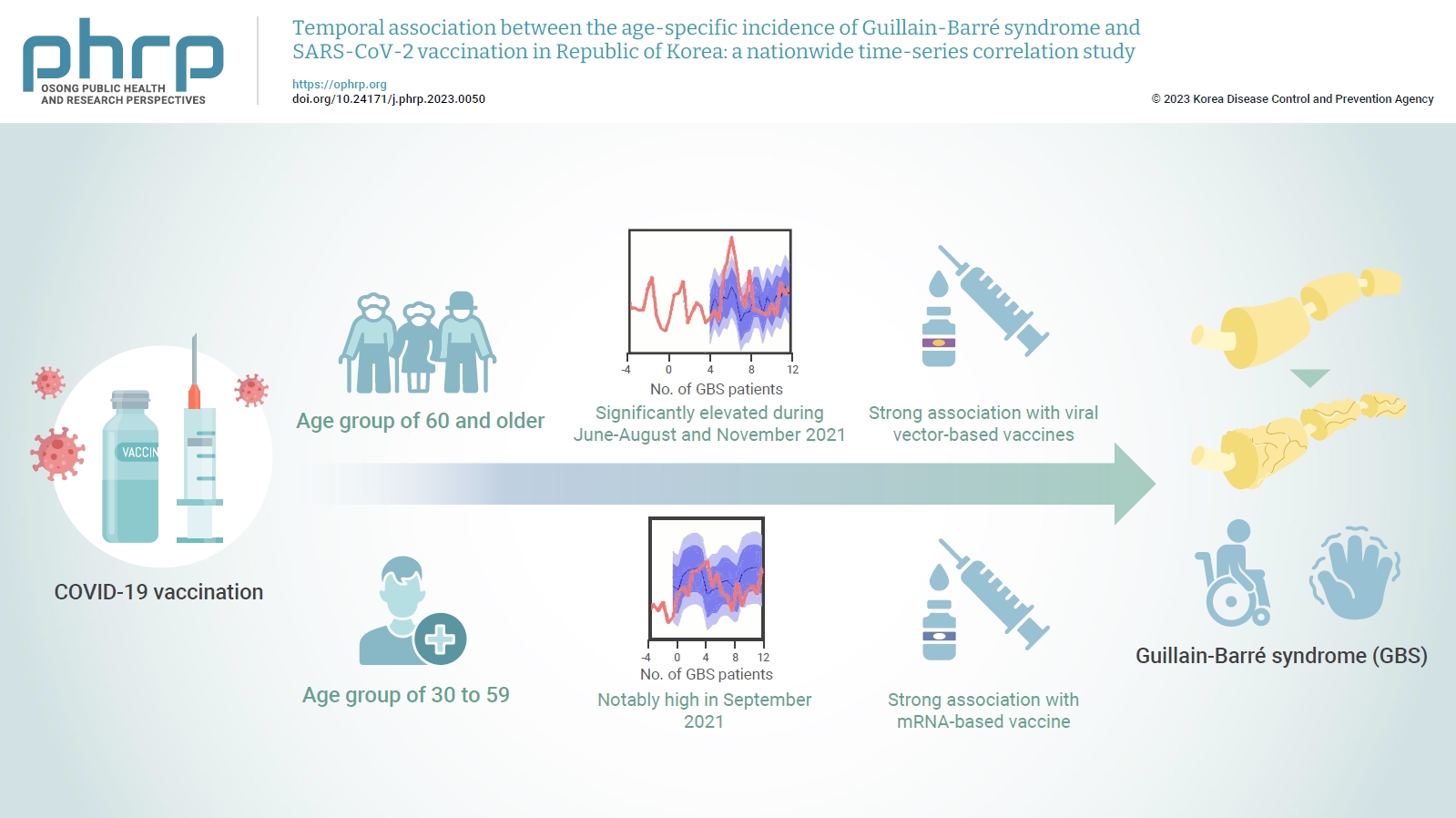
- Objectives
The incidence of Guillain-Barré syndrome (GBS) changed significantly during the coronavirus disease 2019 (COVID-19) pandemic. Emerging reports suggest that viral vector-based vaccines may be associated with an elevated risk of GBS.
Methods
In this nationwide time-series correlation study, we examined the age-specific incidence of GBS from January 2011 to August 2022, as well as data on severe acute respiratory syndrome coronavirus 2 (SARS-CoV-2) vaccinations and infections from February 2021 to August 2022. We compared the forecasted estimates of age-specific GBS incidence, using the pre-SARS-CoV-2 period as a benchmark, with the actual incidence observed during the post-vaccination period of the pandemic. Furthermore, we assessed the temporal association between GBS, SARS-CoV-2 vaccinations, and COVID-19 for different age groups.
Results
In the age group of 60 and older, the rate ratio was significantly elevated during June-August and November 2021. A significant, strong positive association was observed between viral vector-based vaccines and GBS incidence trends in this age group (r=0.52, p=0.022). For the 30 to 59 years age group, the rate ratio was notably high in September 2021. A statistically significant, strong positive association was found between mRNA-based vaccines and GBS incidence in this age group (r=0.61, p=0.006).
Conclusion
Viral vector-based SARS-CoV-2 vaccines were found to be temporally associated with an increased risk of GBS, particularly in older adults. To minimize age-specific and biological mechanism-specific adverse events, future vaccination campaigns should adopt a more personalized approach, such as recommending homologous mRNA-based SARS-CoV-2 vaccines for older adults to reduce the heightened risk of GBS. -
Citations
Citations to this article as recorded by- mRNA-LNP COVID-19 Vaccine Lipids Induce Complement Activation and Production of Proinflammatory Cytokines: Mechanisms, Effects of Complement Inhibitors, and Relevance to Adverse Reactions
Tamás Bakos, Tamás Mészáros, Gergely Tibor Kozma, Petra Berényi, Réka Facskó, Henriette Farkas, László Dézsi, Carlo Heirman, Stefaan de Koker, Raymond Schiffelers, Kathryn Anne Glatter, Tamás Radovits, Gábor Szénási, János Szebeni
International Journal of Molecular Sciences.2024; 25(7): 3595. CrossRef - Guillain–Barre syndrome following COVID-19 vaccination: a study of 70 case reports
Biki Kumar Sah, Zahra Fatima, Rajan Kumar Sah, Bushra Syed, Tulika Garg, Selia Chowdhury, Bikona Ghosh, Binita Kunwar, Anagha Shree, Vivek Kumar Sah, Anisha Raut
Annals of Medicine & Surgery.2024; 86(4): 2067. CrossRef
- mRNA-LNP COVID-19 Vaccine Lipids Induce Complement Activation and Production of Proinflammatory Cytokines: Mechanisms, Effects of Complement Inhibitors, and Relevance to Adverse Reactions





 First
First Prev
Prev


